Understanding the State of CX in the Banking Industry
How does the quality of customer experience differ across industries? To address this question, the XM Institute conducted a large-scale benchmark study where we asked 10,000 U.S. consumers to rate their recent interactions with 294 organizations across 20 industries.1 In this Industry Snapshot, we examine the state of CX in the banking industry. To develop this Industry Snapshot, we:
- Found the average XMI Customer Ratings – Overall for each industry. To generate the average CX rating for each industry, we asked respondents to evaluate their experiences with companies over the past 90 days.2 These questions – rated on a seven-point scale – covered the three components of an experience: success (were they able to accomplish their goals?), effort (how easy or difficult was it for them to accomplish their goals?), and emotion (how did the interaction make them feel?).3 We found the XMI Customer Rating – Overall for each of the 294 companies by averaging the ratings for these three experience components. We then calculated the average Customer Rating for each industry by averaging the Customer Ratings of the companies within each industry.4
- Calculated NPS. We asked respondents who had interacted with a company to answer the standard Net Promoter® Score (NPS®) question: How likely are you to recommend <company> to friends and colleagues? Consumers selected a response from 0 (not at all likely) to 10 (extremely likely). We then determined the percentages of each firm’s respondents who were promoters (selected 9 or 10), passives (selected 7 or 8), or detractors (selected between 0 and 6). We then calculated the NPS for each company by subtracting its percentage of detractors from its percentage of promoters.5
- Determined likelihood to repurchase and trust. We also asked consumers how likely they are to consider purchasing more products or services from the companies they had interacted with on a scale of 1 (extremely unlikely) to 7 (extremely likely). We also asked how likely they are to trust that the company would take care of their needs on a scale from 1 (do not trust at all) to 7 (completely trust).
- Established the frequency and effects of poor experiences. We asked respondents to identify which organizations they recently had a poor experience with and then asked, “Since the time that you had a bad experience with these companies, how have you changed the amount of money you spend with them?” They could answer that their spending completely stopped, it decreased, it didn’t change, it increased, or that they haven’t spent any money with that company.
- Identified the most broken customer journeys. To better understand which types of interactions are most likely to affect the customer’s perception of an organization, we asked respondents to identify which journey within a certain industry needs the most improvement. We also looked at the correlation between which journeys a customer identified as broken and how likely that customer was to recommend the company.
Banks Deliver Above Average CX
When we looked at the current state of customer experience in the banking industry and how it compared to the broader CX landscape, we found that banks:
- Outperform other industries in the Customer Ratings. Banks received an average XMI Customer Rating – Overall score of 70%, tying for third place out of 20 industries
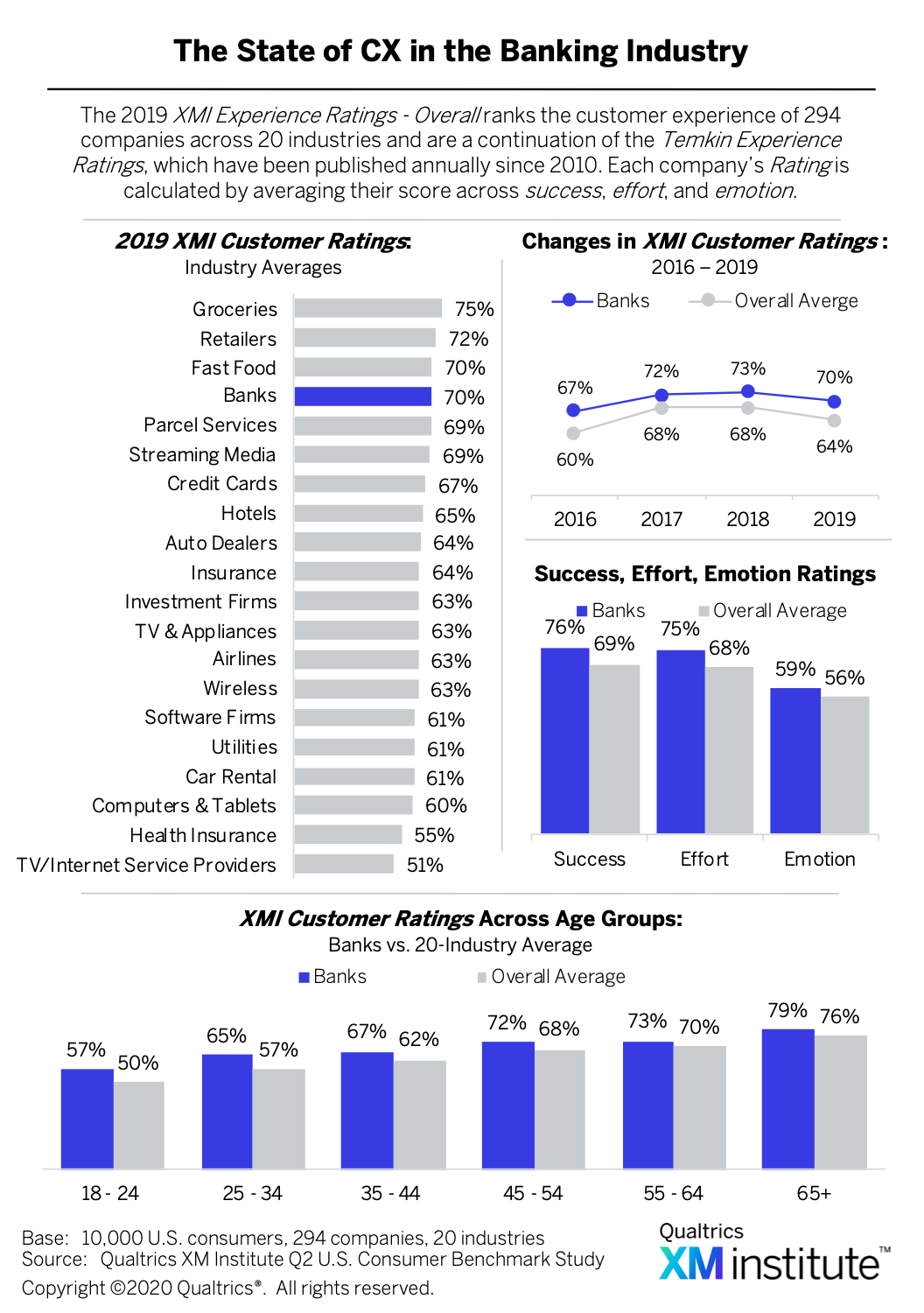 . When we looked at how the banking industry average changed across different age groups, we found that while banks outperform the 20-industry average in every age group, they do particularly well with consumers between the ages of 18 and 34.
. When we looked at how the banking industry average changed across different age groups, we found that while banks outperform the 20-industry average in every age group, they do particularly well with consumers between the ages of 18 and 34. - Receive an average Net Promoter Score. We found a strong connection between customers’ experiences and their likelihood to recommend a company. Companies that significantly outperformed their industry’s average Customer Ratings also earned a significantly higher-than-average NPS
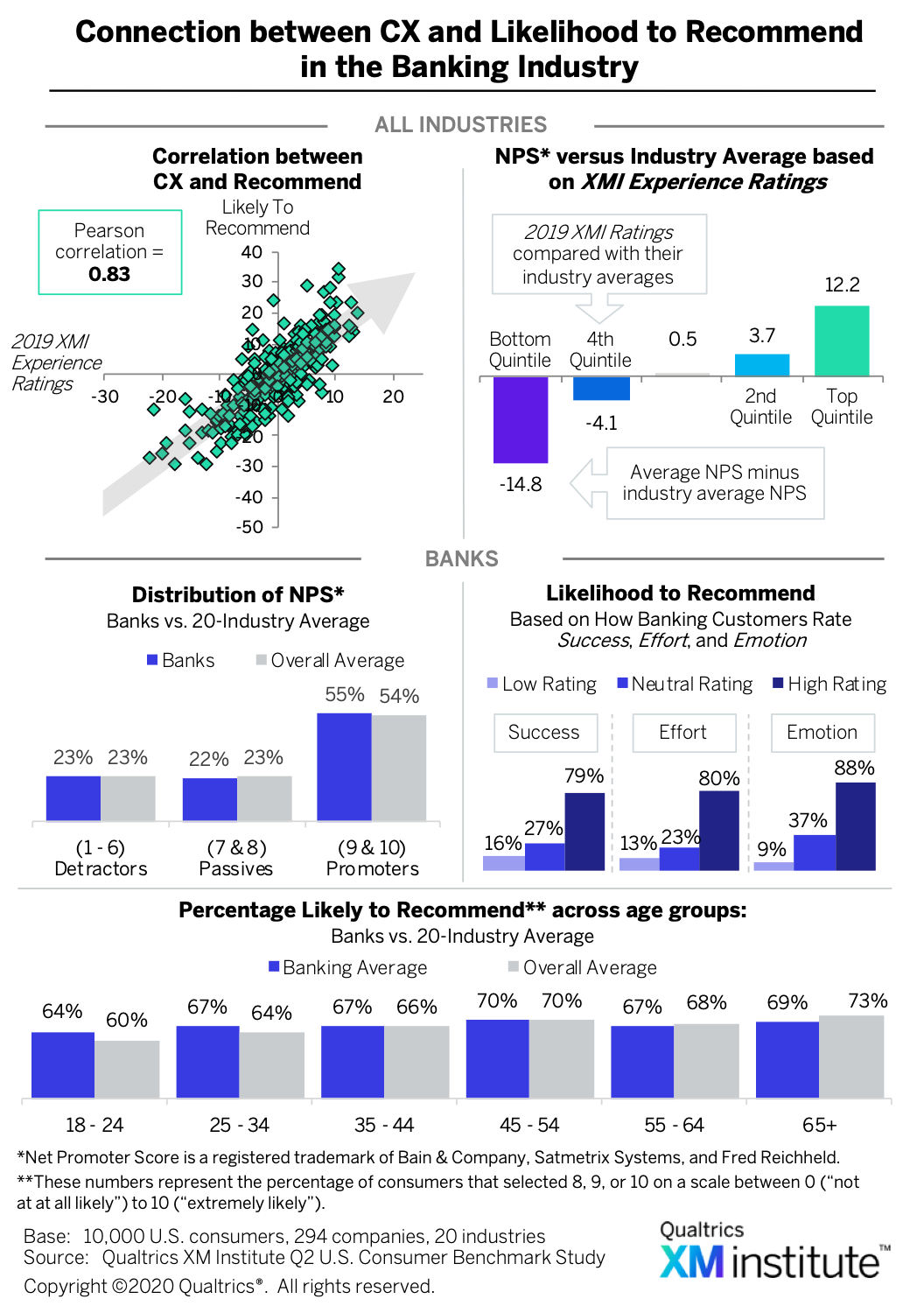 . However, despite earning one of the highest average Customer Ratings, the banking industry receives only an average NPS. To boost their numbers of promoters, banks should focus the emotion component of experiences as, of the three elements of an experience, it has the most significant impact on a customer’s likelihood to recommend. In fact, 88% of customers who gave a bank a high score for emotion say that they are likely to recommend the company.
. However, despite earning one of the highest average Customer Ratings, the banking industry receives only an average NPS. To boost their numbers of promoters, banks should focus the emotion component of experiences as, of the three elements of an experience, it has the most significant impact on a customer’s likelihood to recommend. In fact, 88% of customers who gave a bank a high score for emotion say that they are likely to recommend the company. - Lack enthusiasm amongst older customers. Customer experience is strongly related to a consumer’s likelihood to rebuy from a company – with a correlation coefficient of 0.85
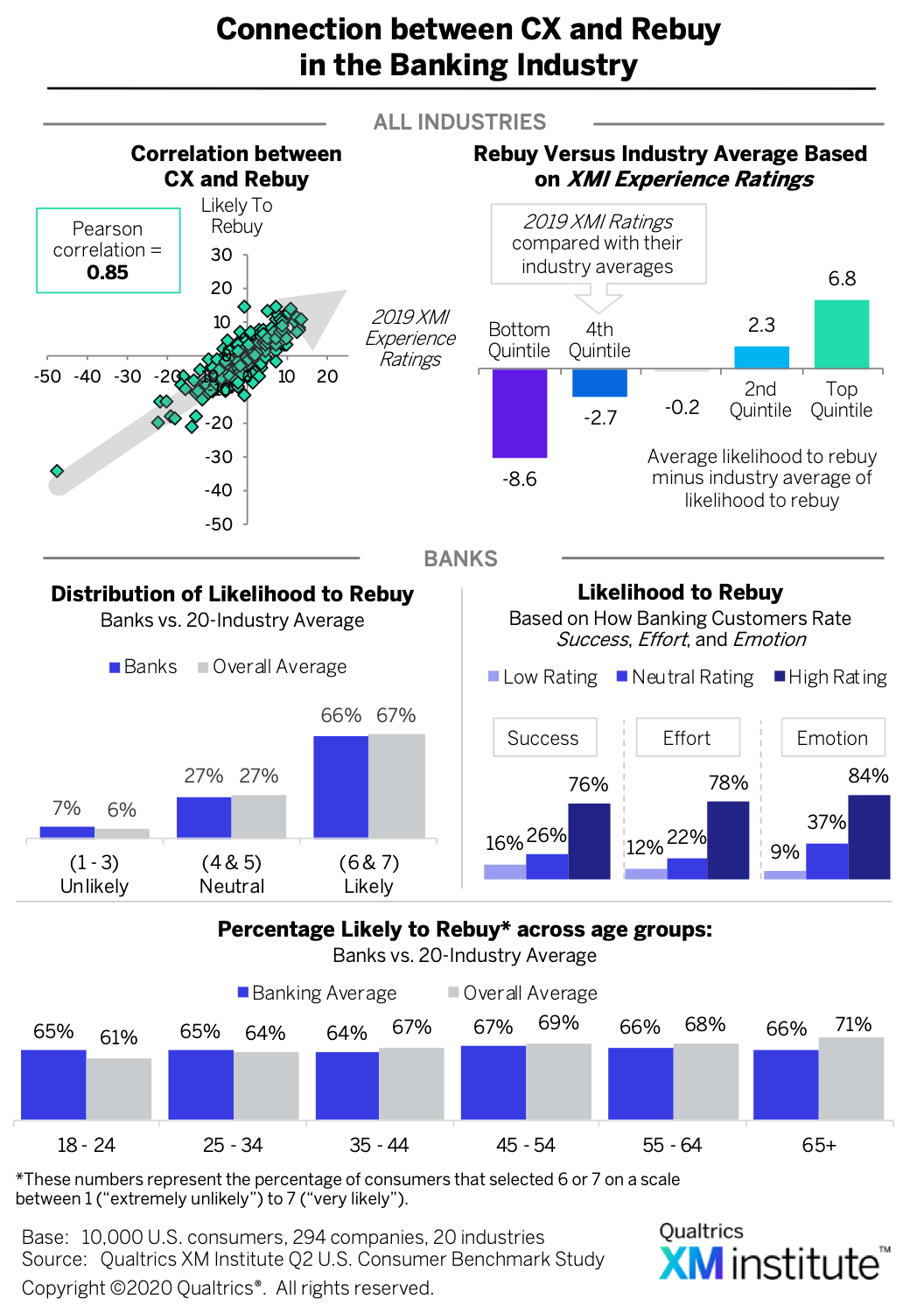 . While banks enjoy higher-than-average likelihood to repurchase scores amongst younger customers, they lag behind the 20-industry average for customers over the age of 65, trailing the overall average by five percentage-points.
. While banks enjoy higher-than-average likelihood to repurchase scores amongst younger customers, they lag behind the 20-industry average for customers over the age of 65, trailing the overall average by five percentage-points. - Inspire customer trust. While a customer’s experience with a company does impact their likelihood to trust that company, the correlation is slightly weaker than it is for their likelihood to recommend or repurchase
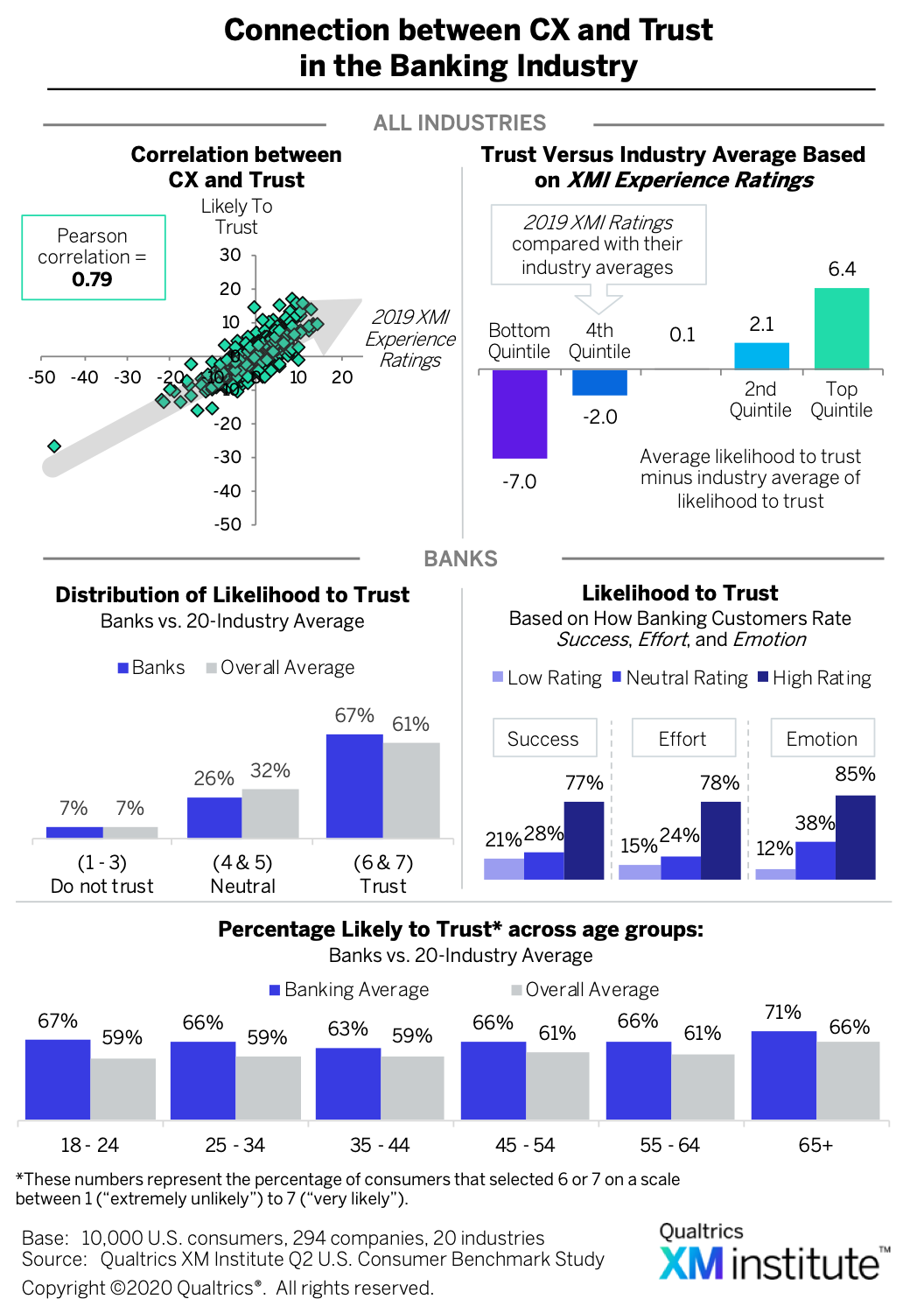 . While banks’ NPS and likelihood to repurchase scores are fairly average, they significantly outperform the cross-industry average when it comes to trust, with over two-thirds of customers saying that they trust banks to take care of their needs. The difference between the banking average and the overall average is particularly stark in the two youngest age groups, where the percentage of customers who trust banks is over 7 percentage-points higher than the 20-industry average.
. While banks’ NPS and likelihood to repurchase scores are fairly average, they significantly outperform the cross-industry average when it comes to trust, with over two-thirds of customers saying that they trust banks to take care of their needs. The difference between the banking average and the overall average is particularly stark in the two youngest age groups, where the percentage of customers who trust banks is over 7 percentage-points higher than the 20-industry average. - Deliver few bad experiences. Only 6% of customers who interacted with a bank over the previous six months say they had a bad experience
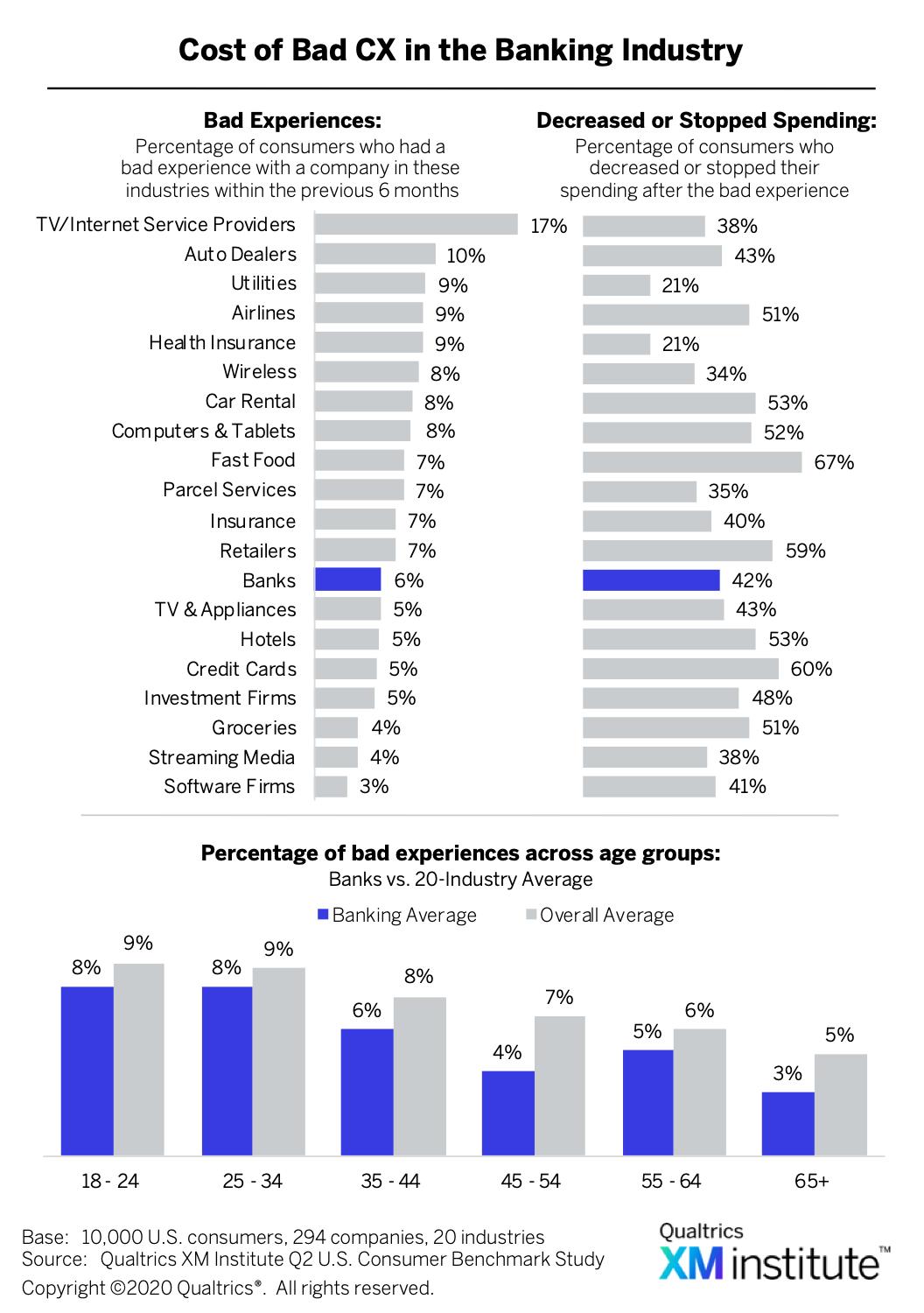 . However, of those customers who did endure a poor experience, 42% of them say that they either decreased or stopped spending after that poor interaction, which is fairly average across industries. And while banks deliver fewer bad experiences compared to the overall average across all age groups, the gap is particularly noticeable in the 45 to 54 age group.
. However, of those customers who did endure a poor experience, 42% of them say that they either decreased or stopped spending after that poor interaction, which is fairly average across industries. And while banks deliver fewer bad experiences compared to the overall average across all age groups, the gap is particularly noticeable in the 45 to 54 age group. - Make it difficult for customers to find a convenient branch. Fifteen percent of customers identified “finding a convenient branch location” as in need of significant improvement
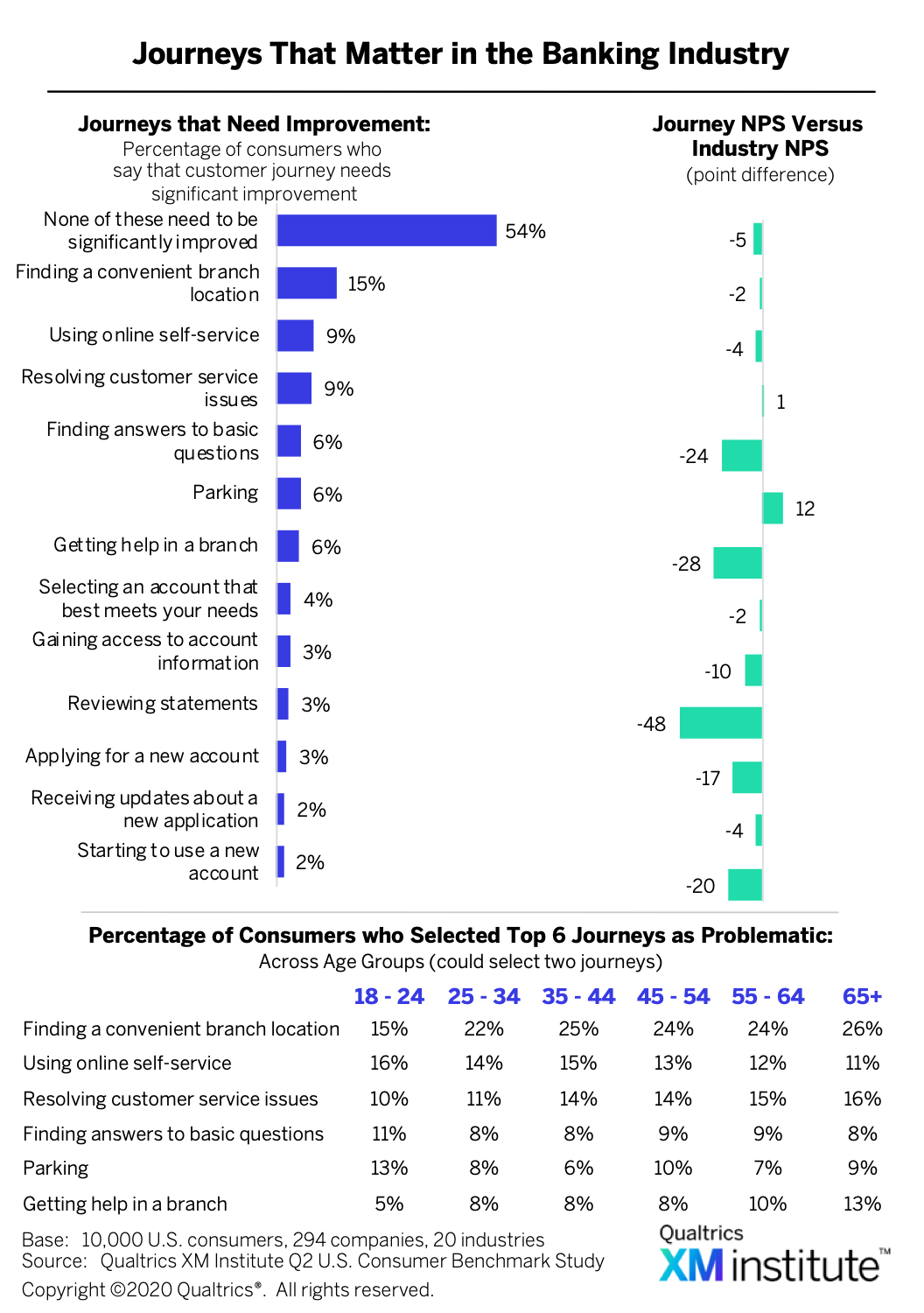 . However, customers who identified this journey as broken only gave an NPS that was two points below the industry average, whereas customers who selected “reviewing statements” as a problematic journey gave an NPS that was 48 points the industry average.
. However, customers who identified this journey as broken only gave an NPS that was two points below the industry average, whereas customers who selected “reviewing statements” as a problematic journey gave an NPS that was 48 points the industry average.
Propel Your Customer Experience to the Next Level
In the decade since the financial crisis brought widespread attention to how the banking industry treated its customers, many banks have made customer-experience transformation – especially digital CX – a strategic priority. To thrive in this changing competitive landscape, banks must establish Experience Management (XM) as an organizational discipline by mastering six XM Competencies and 20 XM Skills 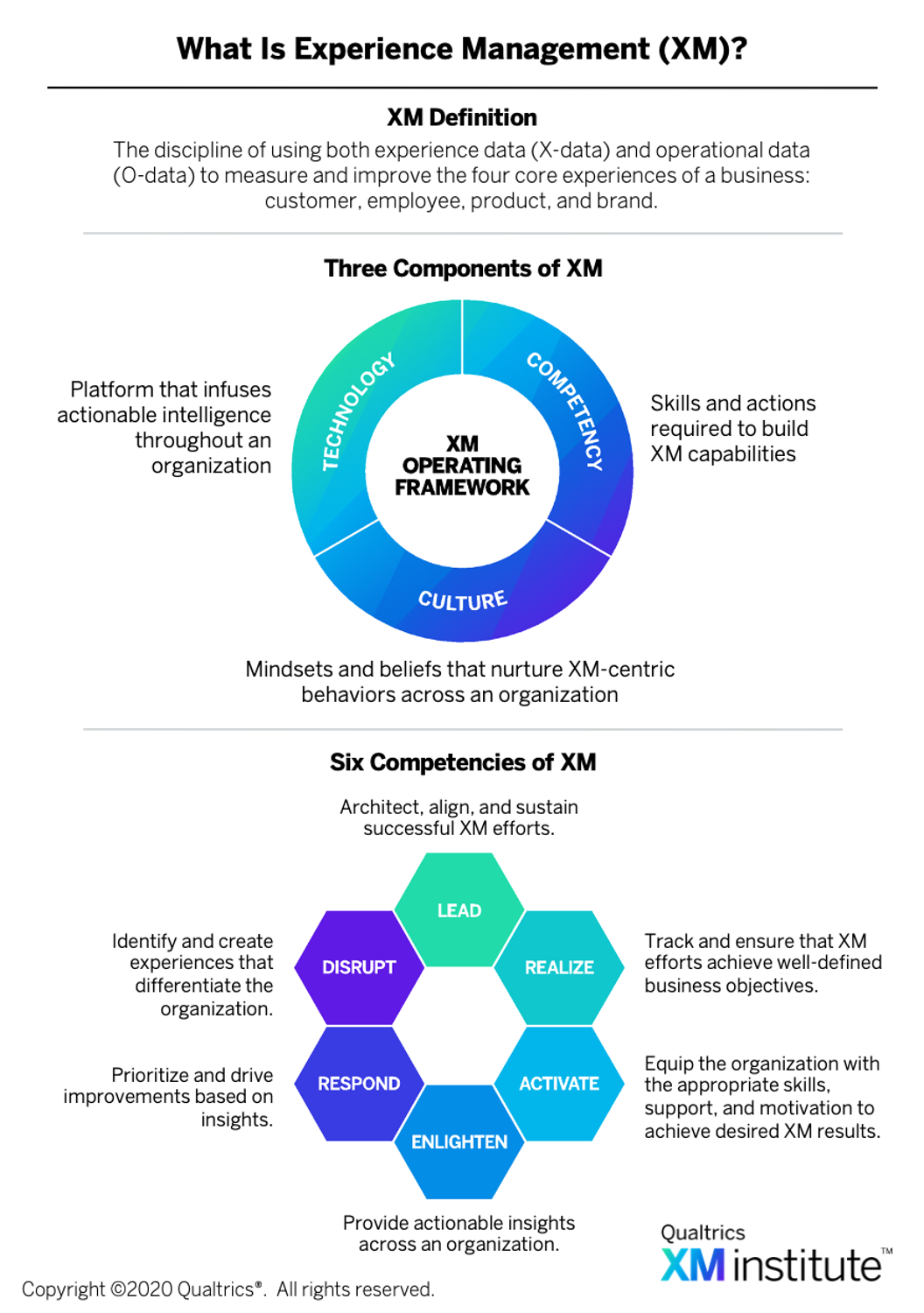 .6 These capabilities will help banks succeed in the new environment by allowing them to:
.6 These capabilities will help banks succeed in the new environment by allowing them to:
- Continuously learn. Banks with strong XM Competencies and Skills will be able to continuously collect and analyze feedback and behavioral signals from the people who interact with them – gathering the information necessary for understanding the experiences, perceptions, and attitudes of their customers, employees, and prospects. For example, banks with robust XM capabilities will be able to identify which moments most affect the loyalty of key customer segments – such as finding a local branch or reviewing statements – and then establish listening posts that collect ongoing insights about the quality of those interactions. These insights will include experience data (X-data) like NPS or satisfaction scores as well as operational data (O-data) like products owned or demographic information. Banks who are capable of combining these two types of data will be able to more accurately forecast the value of CX improvements and gain a deeper understanding of their customers’ actual experiences. For instance, a bank may find that older customers give it lower customer effort scores because they find its mobile app confusing to navigate.
- Propagate insights. Once banks understand how the people who interact with them think, behave, and feel, they will then need to get those insights into the hands of the people across their ecosystems who are best equipped to act on that information. For example, banks with strong XM skills will not only recognize that, say, getting help in a branch is an important journey for customers, they will also be able to quickly share qualitative and quantitative insights about those interactions with the people who are directly and indirectly responsible for delivering them, such as bank tellers and branch managers. Furthermore, they will tailor both the content and the form of these insights for each role, with customized alerts triggered when certain criteria – such as a low score for satisfaction or cleanliness – are met.
- Rapidly adapt. Distributing customer insights in the right form to the right people across the organization will allow banks to act quickly on the intelligence they’ve collected and shared, thus enabling them to rapidly create or improve experiences in a way that addresses people’s changing needs and expectations. For example, customers’ feedback may highlight that transferring money to a different account is a key pain point because the stakes are often so high, and the money can take several days to show up in the new account. Using these insights, a bank’s digital team could include a feature in its app that allows customers to easily track this process.
- Data comes from the Qualtrics XM Institute Q2 2019 Consumer Benchmark Survey – an online study of 10,000 U.S. consumers completed during May 2019. Survey respondents were representative of the U.S. Census based on quotas for age, income, ethnicity, and geographic region.
- See the XM Institute report, “2019 XMI Customer Ratings – Overall,” (September 2019). The XMI Customer Ratings – Overall are a continuation of the Temkin Experience Ratings. The Ratings were renamed after Qualtrics purchased Temkin Group in October 2018.
- We developed ratings for each of the three components of an experience – success, effort, and emotion – by subtracting the percentage of consumers who rated a company poorly from the percentage of consumers who rated it highly.
- Although consumers rated a number of companies for our survey, we only analyzed the ones that received at least 100 consumer responses. Ultimately, we examined data from 294 companies across 20 industries. For this Industry Snapshot, data on banks comes from over 5,500 respondents evaluating their experiences with 15 large banks.
- See the XM Institute report, “2019 XMI Customer Ratings – Consumer NPS,” (October 2019).
- See the Qualtrics XM Institute report, “Operationalizing XM” (July 2019).





